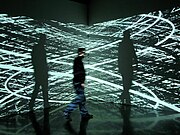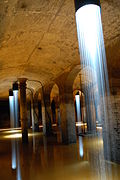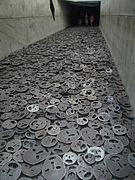Installation art
Installation art is an artistic genre of three-dimensional works that are often site-specific and designed to transform the perception of a space. Generally, the term is applied to interior spaces, whereas exterior interventions are often called public art, land art or art intervention; however, the boundaries between these terms overlap.
See also: Interactive artGesamtkunstwerk[edit]
The conscious act of artistically addressing all the senses with regard to a total experience made a resounding debut in 1849 when Richard Wagner conceived of a Gesamtkunstwerk, or an operatic work for the stage that drew inspiration from ancient Greek theater in its inclusion of all the major art forms: painting, writing, music, etc. (Britannica). In devising operatic works to commandeer the audience's senses, Wagner left nothing unobserved: architecture, ambience, and even the audience itself were considered and manipulated in order to achieve a state of total artistic immersion. In the book "Themes in Contemporary Art", it is suggested that "installations in the 1980s and 1990s were increasingly characterized by networks of operations involving the interaction among complex architectural settings, environmental sites and extensive use of everyday objects in ordinary contexts. With the advent of video in 1965, a concurrent strand of installation evolved through the use of new and ever-changing technologies, and what had been simple video installations expanded to include complex interactive, multimedia and virtual reality environments".
Immersive virtual reality[edit]
With the improvement of technology over the years, artists are more able to explore outside of the boundaries that were never able to be explored by artists in the past.[5] The media used are more experimental and bold; they are also usually cross media and may involve sensors, which plays on the reaction to the audiences' movement when looking at the installations. By using virtual reality as a medium, immersive virtual reality art is probably the most deeply interactive form of art.[6] By allowing the spectator to "visit" the representation, the artist creates "situations to live" vs "spectacle to watch".[7]
Contemporary installation organizations and museums
Installation art



![Milton Becerra Ale'ya, Durban Segnini Gallery, Miami, 2009[8]](http://upload.wikimedia.org/wikipedia/commons/thumb/1/17/Aleya-milton-becerra.jpg/180px-Aleya-milton-becerra.jpg)









